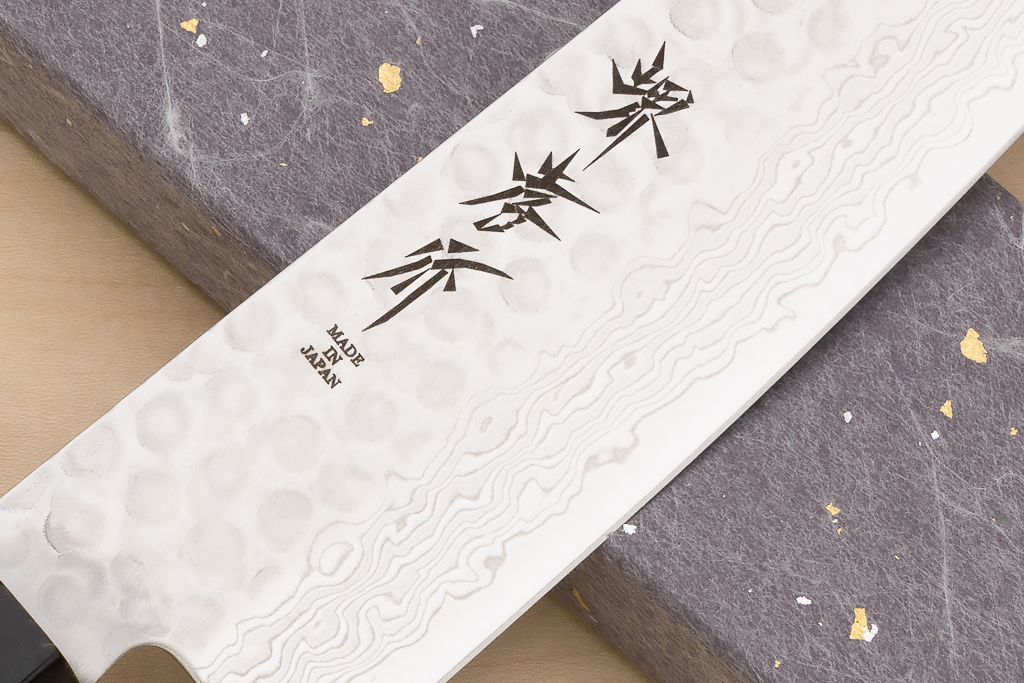VG10 ADVANTAGES
Even at creating the formula for this metal, Japanese craftsmen made solid and durable steel specifically for kitchen knives. They considered that a professional kitchen tool's sharpness and excellent cutting properties are crucial, while it must be corrosion-resistant and keep sharp for a long time. They managed to achieve this goal due to the chemical composition and the peculiarities of the technological production process - heat treatment and "lining." But let's not get ahead of ourselves. To begin with, let's outline the indisputable advantages of knives made of VG-10 steel:premium products with high practical and strength characteristics;
at high hardening hardness (up to 61 HRC), they can be easily sharpened with suitable abrasives (water stones of certain grain size);
durability and versatility of use;
high corrosion resistance (blades are resistant even to the appearance of pitting corrosion - dark spots).
DISADVANTAGES OF VG10
From the consumer's point of view, the kitchen knife VG-10 has the only drawback - a relatively high price. For example, VG-10 will cost much more than stainless steel, but at the same time, it will also serve without loss of cut quality much longer. Also, the disadvantages include the need for proper care for such a knife - hand washing, use strictly for the intended purpose, the use of wooden and plastic boards for cutting. However, these rules apply to any high-end blades because professional chefs know how to care for their steel assistants. It is not difficult to organize decent care and storage at home.From the point of view of knife manufacturers, the disadvantage of VG-10 steel is the difficulty in heat treatment. The Japanese meticulously approached the development of technology, so creating a knife from a steel plate is quite laborious and costly. For this reason, global knife brands prefer to buy finished steel from Japan and work with this material.
CHEMICAL COMPOSITION VG10
In addition to the standard components of any iron carbon and chromium, the creators of VG-10 have added a variety of alloying substances to the formula. Most notable is cobalt, which steelmakers infrequently use due to its high cost. Molybdenum and vanadium added elasticity and increased corrosion resistance. The result is very hard, tough, highly hardened high carbon steel. Let's list all its components:1.C (carbon) - 1-2%. The main "hardener", connecting link for the elements of the crystal lattice.
2. Cr (chromium) - 14.5-15.5%. This content is considered high for knife steel. This component increases resistance to corrosion and mechanical damage and increases the ability to harden.
3. Mo (molybdenum) - 0.90-1.20%. Provides knife response and reduces sensitivity to high temperatures due to its refractory properties. Prevents edge brittleness.
4. V (vanadium) - 0.10-0.30%. It gives the steel the necessary toughness, enhancing the effect of chromium, provides the chemical inertness of the blade, and thus extends its service life.
5. Co (cobalt) - 1.30-1.50%. Due to which steel acquires heat resistance, the most expensive component makes it possible to harden the metal at very high temperatures.
TECHNOLOGICAL PROCESS
As we have already said, in many respects, the high strength and performance characteristics of Japanese knives made of VG-10 are provided by a special technology for the production of this steel. These are the steps involved:Metal outflow at a temperature of about 900 ° C.
Heating up to a temperature of 1000-1100 ° C.
Cooling in a gas atmosphere.
Long heating (1-2 hours) at a temperature of 150-200 ° C.
The manufacturer gives the workpiece a finished look at the final stage, grinds, and sharpens the future blade. Any deviations from the temperature regime or the holding time can lead to the fact that the resulting metal will be unsuitable for manufacturing knives. Steel is also used for the production of multi-purpose tools in the aircraft and auto industries.
Knives made of VG-10 premium steel have a relatively high price, but they have high cutting properties, serve without loss of sharpness, and have a presentable appearance for a very long time. It is not for nothing that this steel is chosen by professional chefs who know a lot about the convenience of using knives. Combined with the minimum sharpening angle typical of Japanese blades, such a knife acquires super-sharpness, hardness, and strength.



POST COMMENTS
0 COMMENT(S)